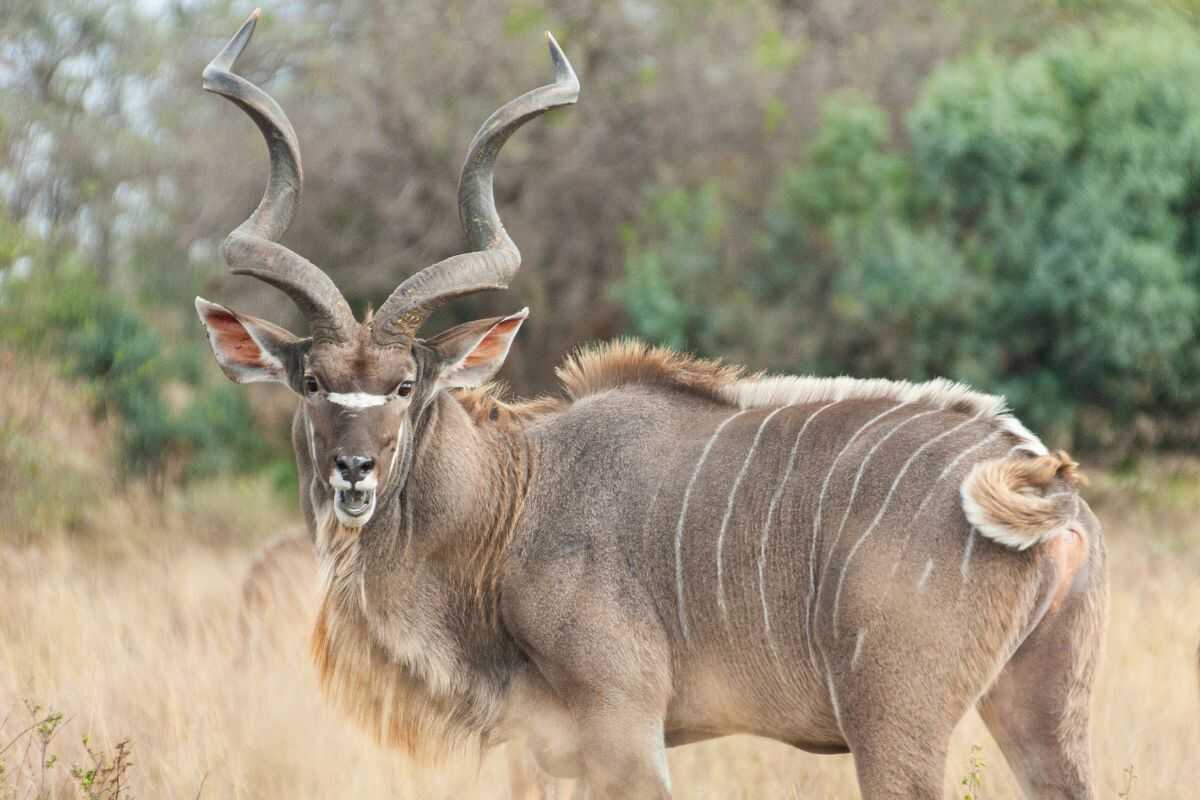

Kudu hunting in Africa is probably one of the most iconic hunts undertaken on the Dark Continent. This striking antelope is well-known for its beautiful coat and long, spiral horns, as well as its exceptional camouflage skills. Often referred to as the “King of the Spiral Horns,” the Kudu is a graceful, striking antelope trophy that will fit well into any trophy room worldwide.
There are two subspecies of the Kudu, namely the Greater Kudu and the Lesser Kudu. The Greater Kudu is found throughout much of sub-Saharan Africa, including South Africa, Mozambique, Zimbabwe, Namibia, Angola, Kenya, Tanzania, and Zambia, while the Lesser Kudu is found in Ethiopia, Kenya, Somalia, South Sudan, Tanzania, and Uganda, amongst others.
Apart from location, these two subspecies differ in numerous ways:
The Greater Kudu’s horns are larger, reaching 2 – 2.5 twists, and a length of 70 inches, while the Lesser Kudu’s horns are smaller, reaching 20-28 inches, with a more relaxed twist of about 2 spiral twists.
The Greater Kudu is larger in size, with a weight of 420-600 pounds. The Lesser Kudu weighs between 130 and 230 pounds.
In terms of appearance, the Lesser Kudu sports 11-15 vertical white stripes compared to the Greater Kudu, which has between 6-10 vertical white stripes.
The Greater Kudu is found in southern and eastern Africa, with habitats including mostly green savannas, hilly wooded areas with dense bush and thickets. The Lesser Kudu prefers the arid and semi-arid regions of northeast Africa, including dry bushlands, woodlands, and dense scrublands.
Both the Greater and Lesser Kudu avoid open areas to evade predators, including Lions, Leopards, and Spotted Hyenas.
While Kudu hunts were traditionally for sustenance, this African plains game antelope has become an iconic trophy, hunted both for its meat and its striking horns. Nowadays, many hunters return to Africa year after year to harvest this popular trophy.
Kudu hunts are usually conducted as part of an African plains game safari and can be anything from 5 days upwards.
The determining factor for a Kudu hunt would be the specific subspecies that is being harvested. For the Greater Kudu, South Africa is one of the best hunting destinations available, with the Eastern Cape province being the frontrunner in terms of trophy bulls, while the Limpopo province is another popular Kudu hunting destination. Zimbabwe’s Matsetsi and Zambezi Valley conservancies produce large Greater Kudu trophies, along with Namibia’s central and northern regions, and Botswana, which also offer good-quality Kudu bulls.
East Africa is the best region to hunt the Lesser Kudu. Due to hunting restrictions and political instability, Ethiopia and Tanzania are recommended for quality Lesser Kudu hunts. Tanzania’s Maasailand provides a popular option for this sought-after trophy, while Kudu hunts in Ethiopia are popular in the Omo Valley and Bale Mountain regions.
The best time to hunt kudu is early morning or late afternoon when this antelope is more active. Hunting methods include the spot-and-stalk, which involves glassing for the antelope from a lookout point and then setting out on foot to stalk it. Alternatively, since the antelope is water-dependent and drinks daily, it is also ambushed near water holes.
Countries such as South Africa are renowned for their exceptional Kudu trophies and allow Kudu hunts throughout the year. The best time to enjoy Kudu hunting in South Africa is during the dry, cooler months when the vegetation is less and allows the hunter better visibility. These months, from around May to August, also see wildlife more likely to be congregating around limited water sources, allowing ambush opportunities.
Other destinations, such as Mozambique, Namibia, Zimbabwe, Zambia, Tanzania, Ethiopia, and Uganda, have shorter hunting seasons to target the Kudu.
The Kudu is seen as one of Africa’s most iconic African plains game species, and a sought-after trophy due to its long-spiral horns and striking coat.
When it comes to Kudu hunting safaris, they can be quite challenging as this antelope has earned the nickname of “Africa’s gray ghost” due to its excellent camouflage skills. Not only that, but this antelope has exceptional hearing, making the stalking of the Kudu quite testing for the hunter.
Kudu hunts test a hunter’s patience, perseverance, and fitness, with long walks through tough terrain and challenging landscapes to hunt this iconic African antelope trophy. Many hunters fall short of claiming this trophy, as Africa’s gray ghost evades even the most skilled and experienced hunting parties.
A standard Kudu hunting safari will form part of an African plains game hunt and include the basic service offerings such as accommodation, meals, drinks, professional hunter, camp staff, trackers, on-territory transport, and field preparation of the trophy.
Exclusions and optional extras when Kudu hunting in Africa:
Whether it’s finding kudu hunts, stalking, or walking and stalking at dawn, we’re here to deliver the experience of a lifetime with integrity and precision.
✉️ Contact us today to speak with an expert and plan your tailored kudu hunting adventure.
🌍 Browse our active hunting listings and secure your preferred species and dates.
Search from our range of Hunts across various popular destinations in Africa.
Find A Hunt